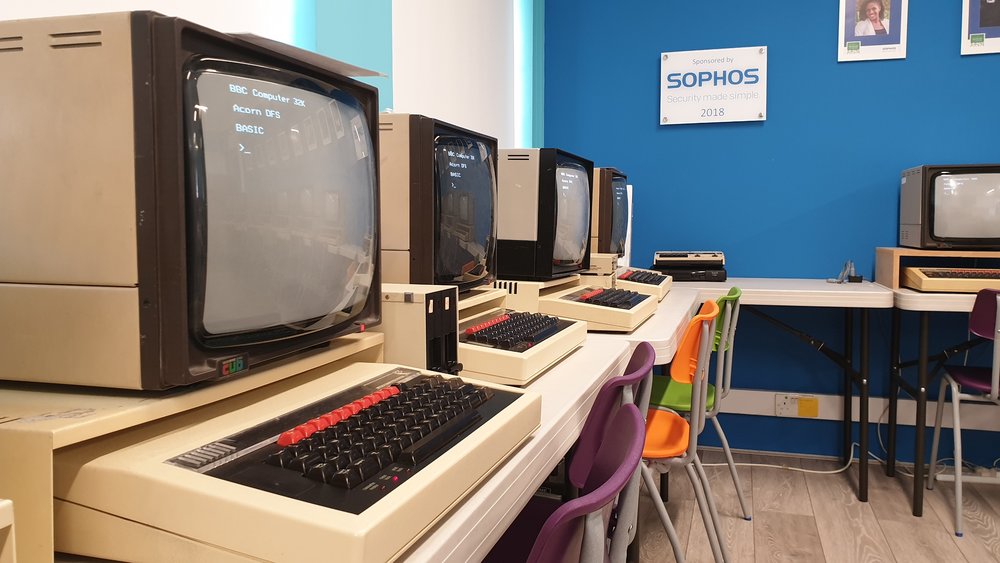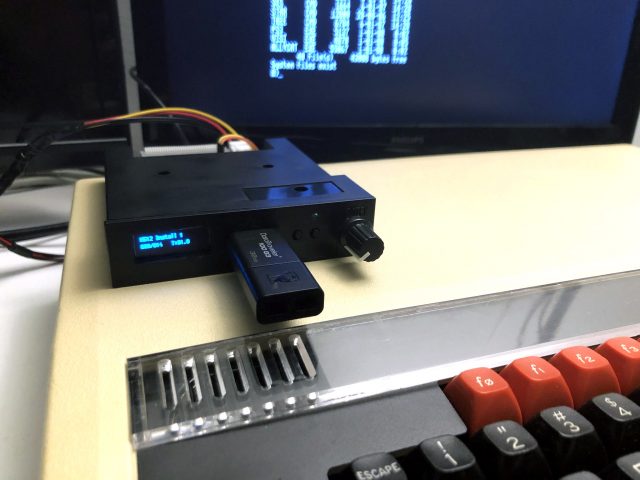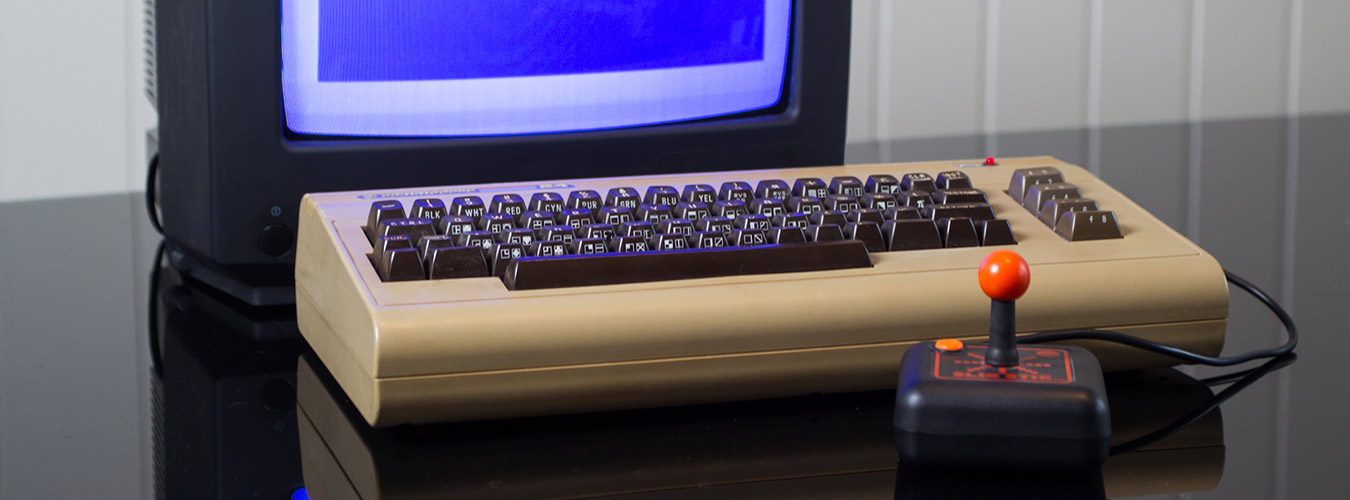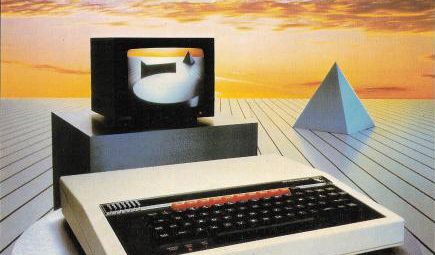Facts
- Type: Home computer
- Manufacturer: Acorn Computers
- Released: December 1981
- Discontinued: 1994
- Introductory price: GBP 335 (Model B), increased to GBP 399
- OS: Acorn MOS
- CPU: MOS Technology 6502/6512 @ 2 MHz
- Memory: 32 KB (Model B)
- ROM: 32 KB (expandable)
- Graphics: 640×256, 8 colors (various frame buffer modes) 78×75, 8 colors (Teletext)
- Audio: Texas Instr. SN76489, 4 chn. mono, TMS5220 speech synthesizer with phrase ROM (optional)
- Units sold: ~1-1.5 million
- Predecessor: Acorn Atom
- Successor: Acorn Archimedes
Released 1981: The British Broadcasting Corporation Microcomputer System, or BBC Micro, is a series of microcomputers and associated peripherals designed and built by the Acorn Computer company in the 1980’s for the BBC Computer Literacy Project, operated by the British Broadcasting Corporation. Designed with an emphasis on education, it was notable for its ruggedness, expandability, and the quality of its operating system. An accompanying 1982 television series, The Computer Programme, featuring Chris Serle learning to use the machine, was broadcast on BBC2.
After the Literacy Project’s call for bids for a computer to accompany the TV programmes and literature, Acorn won the contract with the Proton, a successor of its Atom computer prototyped at short notice. Renamed the BBC Micro, the system was adopted by most schools in the United Kingdom, changing Acorn’s fortunes. It was also successful as a home computer in the UK, despite its high cost. Acorn also employed the machine to simulate and develop the ARM architecture which, many years later, has become hugely successful for embedded systems, including tablets and cellphones. In 2013 ARM was the most widely used 32-bit instruction set architecture.
While nine models were eventually produced with the BBC brand, the phrase “BBC Micro” is usually used colloquially to refer to the first six (Model A, B, B+64, B+128, Master 128, and Master Compact), excluding the Acorn Electron; subsequent BBC models are considered part of Acorn’s Archimedes series.

Impact
During the early 1980s, the BBC started what became known as the BBC Computer Literacy Project. The project was initiated partly in response to an ITV documentary series The Mighty Micro, in which Christopher Evans of the UK’s National Physical Laboratory predicted the coming microcomputer revolution and its effect on the economy, industry, and lifestyle of the United Kingdom.
The BBC wanted to base its project on a microcomputer capable of performing various tasks which they could then demonstrate in the TV series The Computer Programme. The list of topics included programming, graphics, sound and music, teletext, controlling external hardware, and artificial intelligence. It developed an ambitious specification for a BBC computer, and discussed the project with several companies including Acorn Computers, Sinclair Research, Newbury Laboratories, Tangerine Computer Systems, and Dragon Data.
The Acorn team had already been working on a successor to their existing Atom microcomputer. Known as the Proton, it included better graphics and a faster 2 MHz MOS Technology 6502 central processing unit. The machine was only at the design stage at the time, and the Acorn team, including Steve Furber and Sophie Wilson, had one week to build a working prototype from the sketched designs. The team worked through the night to get a working Proton together to show the BBC. Not only was the Acorn Proton the only machine to match the BBC’s specification, it also exceeded it in nearly every parameter. Based on the Proton prototype the BBC signed a contract with Acorn as early as February 1981; by June the BBC Micro’s specifications and pricing were decided.
Hardware
A key feature of the design was the high-performance RAM it was equipped with. A common design note in 6502 computers of the era was to run the RAM at twice the clock rate as the CPU. This allowed a separate video display controller to access memory while the CPU was busy processing the last data it received. In this way, the CPU and graphics driver could share access to RAM through careful timing. This technique was used, for example, on the Apple and the early Commodore models.
The BBC machine, however, was designed to run at the faster CPU speed, 2 MHz, double that of these earlier machines. In this case, bus contention would normally be an issue as there would not be enough time for the CPU to access the memory during the period when the video hardware was idle. Some machines of the era made do with the contention and the inherent performance hit, as was the case for the Amstrad CPC, Atari 8-bit family, and to a lesser extent the ZX Spectrum. Others, like the MSX systems, used entirely separate pools of memory for the CPU and video, which had the disadvantage of slowing access between the two.
In contrast, the Acorn design specified memory able to allow the CPU and video system to access the bus without interfering with each other. To do so, the RAM would have to be able to allow four million access cycles per second. At that time, Hitachi was the only company considering a DRAM that ran at that speed, the HM4816. To equip the prototype machine, the only four 4816s in the country were hand-carried by the Hitachi representative to Acorn.
The Model A shipped with 16 KB of user RAM, while the Model B had 32 KB. Extra ROMs could be fitted (four on the PCB or sixteen with expansion hardware) and accessed via paged memory.
The machines included three video ports, one with an RF modulator sending out a signal in the UHF band, another sending composite video suitable for connection to common computer monitors of the era, and a separate RGB video port. The separate RGB video out socket was originally an engineering requirement from the BBC to allow the machine to directly output a broadcast quality signal for use within television programming.
The machine included a number of input/output interfaces: serial and parallel printer ports; an 8-bit general purpose digital I/O port; a port offering four analogue inputs, a light pen input, and switch inputs; and an expansion connector (the “1 MHz bus”) that enabled other hardware to be connected. An Econet network interface and a disk drive interface were available as options. All motherboards had space for the electronic components, but Econet was rarely fitted.
Additionally, an Acorn proprietary interface named the “Tube” allowed a second processor to be added. Three models of second processor were offered by Acorn, based on the 6502, Z80 and 32016 CPUs. The Tube was later used in third-party add-ons, including a Zilog Z80 board and hard disk drive from Torch that allowed the BBC machine to run CP/M programs.
My repair and upgrades
My machine already had the two “Rifa” AC filter caps replaced when I got it. Those capacitors had a tendency to suddenly “explode” when turning the power on, making a bang and smoke. It also had a MMC/SD card reader fitted with a lot of games.
- PiTubeDirect: It’s possible to use a Raspberry Pi as the different Co-processors that was official available for the BBC Micro back in the days. I’ve got the necessary signal converter board and a Pi Zero from my friend Kjell Sundby (www.sundby.com).
- Advanced Disc Filing System (ADFS): I’ve installed a kit to upgrade to ADFS, this is needed in order to read “PC format” 720KB disks when using “80286” co-processor when using the PiTubeDirect. As my machine had an old disk controller chip, an upgrade was needed to be able to even use a “Gotek” floppy emulator.
- Gotek USB floppy emulator: I’ve connected a Gotek floppy emulator that uses a USB memory stick and disk image files. I’ve modified the Gotek with a OLED display and a rotary encoder knob and installed FlashFloppy software on the Gotek.

My BBC Micro with a Gotek, running DOS Plus with 80286 co-processor

